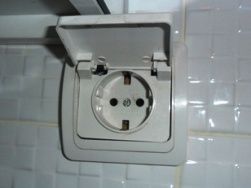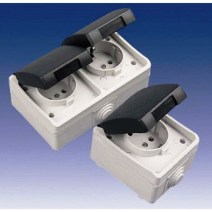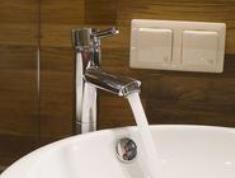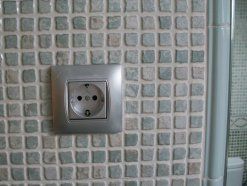Categories: Electrician at home, Sockets and switches
Number of views: 77670
Comments on the article: 10
Outlets in the bathroom
 In the era of actively developing socialism, plug-in sockets in the bathroom considered unnecessary and unnecessary luxury. Therefore, it is hardly possible to see somewhere "Khrushchev" with "native" outlets in the bathroom.
In the era of actively developing socialism, plug-in sockets in the bathroom considered unnecessary and unnecessary luxury. Therefore, it is hardly possible to see somewhere "Khrushchev" with "native" outlets in the bathroom.
But life does not stand still, and the Khrushchev’s are still in operation. And today their owners are increasingly faced with the need to install electrical outlets in the bathroom. It is necessary to connect washing machines, showers, hair dryers, electric shavers and, possibly, some more rare and even exotic types of electrical appliances.
Due to the stereotypes that have developed over decades, sockets in the bathroom were perceived by many electricians as something unnatural: “How so? High humidity, splashes, steel pipes of hot water and cold water, cast-iron risers, and sockets nearby? It’s not just dangerous, but very dangerous! ”
Honestly, there was some truth to this attitude to outlets in the bathroom. Indeed, in the Soviet Union, the nomenclature of household outlets, if it included instances with protection against splashes and moisture, it was almost impossible to get and use them in everyday life. Leakage protection devices were not common.
But today, sockets in the bathroom definitely have the right to life, assigned to them by the current standards of the PUE and GOST R 50571.11-96.
But since you can install sockets in the bathroom, several questions immediately arise:
1) What kind of sockets should these be?
2) What type of wiring should I prefer to install outlets in the bathroom, and which cable should I use?
3) In what place should these sockets be located?
4) What device in the switchboard should protect the lines that supply the sockets in the bathroom?
We will deal with these questions in order.
 1. Of course, anyway you should not put any outlet in the bathroom. There should be splash protection, usually expressed as a spring-loaded cover. For outdoor outlets, which are rarely used in the bathroom for reasons that will be discussed below, a sealed rubberized cable entry is mandatory.
1. Of course, anyway you should not put any outlet in the bathroom. There should be splash protection, usually expressed as a spring-loaded cover. For outdoor outlets, which are rarely used in the bathroom for reasons that will be discussed below, a sealed rubberized cable entry is mandatory.
In general, to avoid any confusion, it is better to just use sockets with a degree of protection against external influences of IP44 and higher. In two-wire lines, in the absence of a grounding line, it is not superfluous to use sockets structurally combined with RCDs with a leakage current rating of 10 mA to connect powerful power consumers, such as a washing machine.
2. It is believed that open wiring in the bathroom is excluded. In fact, this is not entirely true. Open wiring is allowed but undesirable. Open wiring is strictly prohibited in metal hoses. But, since the installation of sockets in the bathroom is usually timed to repair in the apartment, it’s better to exert yourself a little, perform a strobe and lay secretly to the outlet traditional VVGng or NYM cablehaving three conductors with a cross section of 2.5 square meters. mm
 3. The installation location of the outlet in the bathroom, of course, is determined by the intended location of the equipment that we will connect. After all, if you can still install sockets in the bathroom, then there are definitely no places for extension cords and tees.
3. The installation location of the outlet in the bathroom, of course, is determined by the intended location of the equipment that we will connect. After all, if you can still install sockets in the bathroom, then there are definitely no places for extension cords and tees.
But, on the other hand, even purely intuitively, every adult understands that in some places in the bathroom, sockets are still excluded. Such places, for example, can unambiguously include a wall or partition designed for stationary installation of a shower head.
In general, sockets in the bathroom should be located no closer than 0.6 meters from the front door of the shower or directly from the bath.Since at least a small, local "flood" can always occur in the bathroom, it is advisable to place the sockets in this room a little higher, at least at a height of 18-20 centimeters from the floor.
4. With respect to three-wire lines, incorporating a PE conductor, there are practically no questions and doubts about the protection devices for outlet lines in bathrooms.
A differential machine with a maximum current rating of 25 amperes is installed in the apartment panel, or an ordinary machine of the same rating complete with RCD. The rated value of the protection against leakage currents in accordance with the rules should be no more than 30 mA. For new lines, you can safely choose 10 mA devices.
In two-wire lines, it is also possible to use an RCD, and for powerful electrical receivers it can be structurally combined with a power outlet. Power consumers such as an electric shaver or hairdryer can be connected via an optional isolation transformer.
 A few words can be said about technological specifics of installing outlets in the bathroom. The walls in this room are usually tiled. And tile is a very fragile ceramic material. Therefore, for the installation of podrozetniki, you should use special crowns for ceramics, and for drilling holes for plastic dowels - with appropriate drills. In both cases, the hammerless mode is established on the punch, and the cutting must be wet to remove heat from the tool - you will have to add water as you work.
A few words can be said about technological specifics of installing outlets in the bathroom. The walls in this room are usually tiled. And tile is a very fragile ceramic material. Therefore, for the installation of podrozetniki, you should use special crowns for ceramics, and for drilling holes for plastic dowels - with appropriate drills. In both cases, the hammerless mode is established on the punch, and the cutting must be wet to remove heat from the tool - you will have to add water as you work.
After the tile is drilled, for further work, you can arm yourself with ordinary crowns and augers on concrete and put the hammer into shock mode.
See also at e.imadeself.com
:
